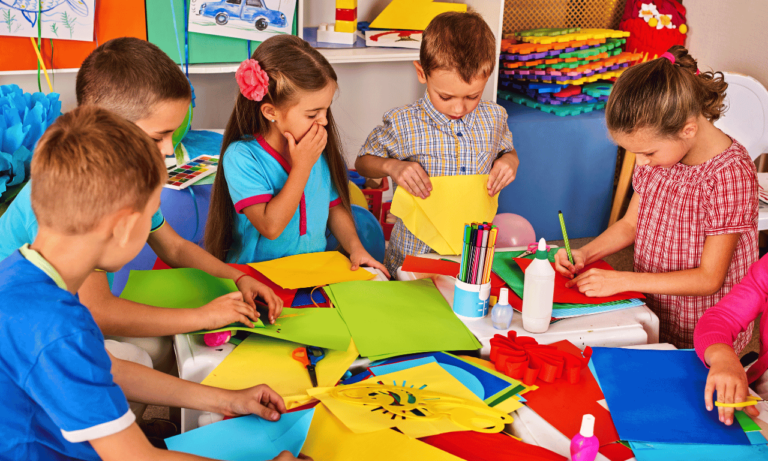Phone:
(+65)8319-0742
In the evolving landscape of education, the integration of Dialogic Teaching and Scaffolding has become a pivotal force in enhancing student learning and cognitive development. Drawing from the wellspring of socio-cultural theory, dialogic teaching strategies harness the transformative power of dialogue, setting the stage for interactive teaching methods that encourage deep thought and comprehensive understanding. It is through such engaging approaches that students are not mere passive recipients, but active constructors of knowledge.
The concept of scaffolding complements these strategies by providing effective scaffolding techniques within the learners’ zones of proximal development. This tailored assistance cultivates an environment where guided interactions elevate each student’s ability to participate meaningfully, moving from peripheral engagement to competent involvement within their community of practiceâa journey towards autonomy and self-regulation that dialogic teaching so greatly empowers.
Key Takeaways
- Socio-cultural theory underscores the importance of dialogic teaching for cognitive development.
- Educators use dialogic teaching strategies to foster student engagement and collaborative knowledge building.
- Effective scaffolding techniques operate within a student’s zone of proximal development to support gradual learning progressions.
- Interactive teaching methods and dialogic engagement in the classroom encourage critical thinking and deeper understanding.
- Autonomy and self-regulation in learners are key goals of integrating dialogic teaching and scaffolding.
The Essence of Dialogic Teaching and Scaffolding in Education
Within the realm of contemporary education, dialogic teaching and scaffolding stand out as fundamental strategies to enhance learning experiences. These approaches are not merely pedagogical choices but are grounded in extensive research and theoretical understanding. They serve as pillars for educational methodologies, aiming to enrich the cognitive and communicative abilities of students through targeted engagement and support.
Defining Dialogic Teaching and Its Role in Learning
Dialogic teaching operates on the principle of fostering meaningful classroom dialogue, creating a vibrant and interactive learning environment where students actively participate in their educational journey. It is characterized by a focus on thoughtful questioning, collective problem-solving, and an emphasis on the importance of student voice and agency. By leveraging the power of conversation and reflection, this educational philosophy cultivates deeper understanding and critical thinking among students.
Conceptualizing Scaffolding Techniques and Their Benefits
Scaffolding in education is likened to the support provided by a scaffold in construction: temporarily necessary and adjustable according to the structure’s evolving stability. In the classroom, educational scaffolding tools provide custom support to students, enabling a just-right challenge that lies within their current reach yet extends towards their potential. As a result, effective scaffolding techniques play a crucial role in helping learners achieve mastery and independence in various academic domains.
- Responsiveness: The ability to tailor the level of support to match the individual learner’s needs.
- Fading: Gradual removal of support as the student gains proficiency, fostering self-reliance.
- Transfer of Responsibility: Encouraging and guiding students to take charge of their own learning process.
| Scaffolding Component | Role in Learning | Impact on Students |
|---|---|---|
| Interactive Dialogues | Engaging students in reflective conversations | Enhanced comprehension and critical thinking |
| Graduated Support | Providing appropriate levels of assistance | Increased independence and skill application |
| Collaborative Knowledge Construction | Facilitating shared learning experiences | Improved communication and social skills |
At its core, the integration of dialogic teaching and robust scaffolding practices in education ensures a balance between learner autonomy and expert guidance, advancing the educational experience towards nurturing students well-prepared to navigate the complexities of the world with confidence and competence.
Dialogic Teaching and Scaffolding: A Socio-Cultural Perspective

The infusion of dialogic teaching strategies into contemporary pedagogy reflects a deep-seated recognition of the socio-cultural dynamics that underpin effective learning. Drawing from a socio-cultural perspective, education is not merely the transfer of knowledge but a rich, interactive process shaped by social engagement and collaborative dialogue. It’s within this interactive framework that scaffolding finds its purpose, functioning as a strategic support system grounded in the realities of classroom interactions and student development.
Renowned researchers, including the likes of Barbara Rogoff, have contributed to our understanding of how children assimilate knowledge and skills through collaborative learning approaches. Rogoff’s examination of participatory appropriation and guided participation articulates a nuanced approach to learning that leverages social interaction as a key component of cognitive growth. This view aligns seamlessly with dialogic teaching, wherein the exchange of ideas is not unidirectional but rather a lively, reciprocal process fostering deeper understanding.
Within the realm of a socio-cultural perspective, dialogic teaching transcends the conventional instructor-led model, championing a mode of education where students and teachers mutually navigate the knowledge terrain. This is especially pertinent in discussions around scaffolding which, true to its construct, offers temporary support structures that evolve and adapt in response to the learner’s progression. The effectiveness of these scaffolding techniques is inherently tied to the concept of the Zone of Proximal Development (ZPD), a term coined by Vygotsky, another stalwart of socio-cultural theory.
The classroom, through the lens of socio-cultural theory, becomes a microcosm of society at large, a space where dialogic teaching strategies mirror real-world problem-solving and knowledge construction. It’s a setting ripe for applying collaborative learning approaches, where students engage in dialogues, critique perspectives, and jointly build upon each other’s ideas, thereby cultivating a community of learners emboldened by active participation and supported by carefully scaffolded instruction. The impact of such practices is profound, setting the stage for lifelong learning founded on a solid base of social cognition and interaction.
Scaffolding Techniques: Contingency, Fading, and Transfer of Responsibility

Fostering meaningful classroom dialogue is an art that requires a carefully structured approach, one that nurtures student engagement and is sensitive to the zone of proximal development of each learner. Scaffolding techniques in education embody this structure through three core elements: contingency, fading, and the transfer of responsibility.
Contingency in scaffolding refers to the tailored assistance educators provide based on individual student needs. It is the educator’s ability to assess and adapt the level of guidance to ensure students remain within their zone of proximal development, thereby maximizing learning outcomes. The fading process involves a gradual reduction of the support students receive, empowering them to apply new knowledge and skills on their own.
The final goal of these techniques is the transfer of responsibility. Once educators have successfully imparted the requisite knowledge and support through scaffolding, the students begin to take ownership of their educational journeys, transforming from passive recipients to active and engaged learners.
The following table outlines the pivotal stages within the scaffolding process and how they contribute to student engagement and development:
| Stage of Scaffolding | Description | Impact on Student Engagement |
|---|---|---|
| Contingency | Adaptation of instructional support to fit the current abilities and progress of the student. | Students feel supported and understood, boosting confidence to participate. |
| Fading | Incremental withdrawal of support, encouraging autonomy. | Students are challenged to apply their learning independently, fostering deeper involvement. |
| Transfer of Responsibility | Shift from teacher-driven support to student-driven learning. | Students take ownership of their learning, driving internal motivation and sustained engagement. |
In essence, these scaffolding techniques are instrumental in unleashing students’ potential. They serve not only to bridge the gap between what a learner can do alone and what they can achieve with help, but also stand as a cornerstone in the journey toward educational empowerment and independence.
Fostering Meaningful Classroom Dialogue through Interactive Teaching Methods

Interactive teaching methods are reshaping the educational landscape, emphasizing the necessity for active learning and engagement. In this shift towards a dialogic model, teachers are finding creative ways to incorporate dialogic teaching strategies and foster meaningful classroom dialogue. These methods are not only enhancing the educational experience but are becoming instrumental in equipping students with the critical thinking skills required for success in the modern world.
Developing the Art of Questioning in a Dialogic Classroom
The transformation from a traditional classroom into a dialogic space begins with questioning. Effective questioning techniques ignite curiosity, prompting students to delve deeper into subjects. It’s a fundamental aspect of dialogic teaching strategies that encourages learners to reflect and develop their ideas, rather than simply recalling facts. As teachers guide classroom discussions with strategic questioning, they are cultivating an environment where students feel empowered to ask and answer complex questions themselves, thus creating a rich tapestry of classroom dialogue.
The Role of Collaborative Learning Approaches
Collaborative learning approaches are the building blocks for a dialogic classroom. By engaging students in group activities that require dialogue and cooperation, they learn to appreciate and consider varied perspectives. These strategies nurture an inclusive environment where every student has a voice, and knowledge is constructed through shared effort and mutual support. This approach encourages students to become active participants in their learning journey, which is paramount in crafting a dynamic educational experience.
| Strategies for Interactive Teaching | Benefits to Classroom Dialogue |
|---|---|
| Socratic questioning | Promotes critical thinking and in-depth analysis |
| Think-pair-share activities | Allows students to articulate thoughts and receive feedback |
| Group discussions with diverse perspectives | Enriches understanding through multiplicity of viewpoints |
| Problem-based learning | Encourages collective problem-solving and knowledge application |
| Peer teaching sessions | Fosters empathy and enhances communicative competence |
By embracing interactive teaching methods and collaborative learning approaches, educators are not just imparting knowledge, but also playing a crucial role in facilitating conversations that matter. As they sow the seeds for open dialogue and intellectual curiosity, teachers are equipping students with the tools necessary for not just academic success but for thriving in the society at large.
Utilizing Educational Scaffolding Tools for Enhanced Student Development
The dynamic field of education continues to evolve with effective scaffolding techniques playing a pivotal role in student development. By integrating educational scaffolding tools into teaching practices, instructors can create a supportive learning environment that adapts to various student needs.
These tools facilitate a customized approach to learning where the level and type of support are meticulously adjusted as students progress. With effective scaffolding, educators can encourage learners to reach new heights of understanding, promoting their journey towards becoming self-sufficient and critical thinkers.
- Targeted Questioning: This technique involves asking questions that are designed to gradually advance students’ comprehension and promote critical thinking.
- Modeling: Demonstrating tasks or thought processes provides students with a blueprint for their own work, which they can emulate and eventually personalize.
- Immediate Feedback: Providing timely and specific feedback helps students recognize their strengths and areas for improvement in real-time.
- Guided Prompts: Prompts and cues can steer student learning until such scaffolds are no longer necessary as student mastery is achieved.
As students become more adept and confident in their abilities, the supports provided by these educational scaffolding tools are gradually removed. This encourages independence, ensuring that learners are not only receiving information but are learning how to effectively navigate and apply knowledge independently.
The utilization of educational scaffolding tools fosters an environment where successful cognitive and academic development thrives. It represents the commitment of educators to empower each student, positioning them to flourish in the knowledge-centric world of the future.
Examining Effective Scaffolding Techniques in Diverse Educational Contexts
Within today’s varied educational landscapes, the application of dialogic teaching strategies and scaffolding in education play pivotal roles. Effective scaffolding adjusts to the academic and emotional landscape of each classroom, personalized to enrich students’ educational experiences substantially. Emphasizing fostering meaningful classroom dialogue and promoting discourse in learning, we can explore how responsiveness and adaptability in teaching delineate success in multitudinous learning environments.
The Importance of Responsiveness in Scaffolding
The heartbeat of effective scaffolding lies in its responsiveness. Teachers must keenly observe and intuitively react to the nuanced needs of their pupils, shaping their support to fit each child’s learning path. It’s through this intuition that scaffolding transcends a mere educational approach, reflecting dedication to the individual’s growth and the collective progress of the classroom. Inherent to these dialogic teaching strategies is the capacity to listen openly, enabling students’ thoughts and queries to steer educational exploration.
Embracing Flexibility and Adaptability in Teaching Practices
As educators, we must wield flexibility in our scaffolding approaches to address the diverse capabilities of our scholarsâa testament to adaptability’s critical role in bolstering scaffolding in education. Teaching practices that embrace such fluidity can bolster classroom environments where students feel sufficiently supported yet free to stretch their academic wings.
| Scenario | Traditional Approach | Adaptive Scaffolding |
|---|---|---|
| Learner Struggling with a Concept | Additional Homework | One-on-One Dialogue to Address Misunderstandings |
| Learner Excels Quickly | Move to Next Unit | Provide Extension Activities to Deepen Understanding |
| Learner Lacks Engagement | Call Out Involvement | Cultivate Interest Through Relatable Contexts |
| Group Learning Dynamic | Fixed Group Roles | Rotating Roles to Promote Equitable Participation |
Through the lattice of dialogic and scaffolding strategies, we can entwine the progressive ideals of educational theorists with pragmatic teaching practices. It embodies a philosophy where promoting discourse in learning and fostering meaningful classroom dialogue become the cornerstones, ensuring each student’s voice not only resonates within the classroom walls but echoes beyond into their life-long educational journey.
Dialogic Teaching and Scaffolding: Strategies for Active Participation
Embracing student-centered dialogues is at the forefront of creating a dynamic classroom atmosphere where dialogic teaching and scaffolding serve as pillars for educational success. Through the deliberate cultivation of these dialogues, educators are rewiring the conventional structure of teaching to place students at the helm of their learning journey. Initiating this transformative approach requires a mindful integration of educational scaffolding tools that support and challenge learners to take charge of the discourse, thus enhancing their intrinsic motivation and academic performance.
Cultivating Student-Centered Dialogues
At the essence of student-centered dialogues is the belief that every learner’s voice is pivotal in the shared knowledge construction process. Educational scaffolding tools play a critical role here, equipping instructors with the framework needed to encourage active and informed participation among students. These dialogues are not simply exchanges of ideas but are instrumental in forming a learner’s ability to engage critically with the content, fostering a proactive rather than reactive learning environment.
Promoting Discourse in Learning
Within the scope of promoting discourse in learning, dialogic teaching and scaffolding strategies are exceptional in their capacity to ignite analytical thinking and competence in communication. Cultivating such an environment where discourse is prioritized facilitates students in exploring complex concepts deeply and with nuance. The ultimate goal is to foster a classroom culture that thrives on collaborative discourse and positions students not as passive recipients of knowledge but as active architects of their educational narrative.
Encouraging learners to take active roles through dialogic teaching and scaffolding prepares them for the intricacies of real-world challenges. As they navigate the scaffolds in place, students progress from guided exploration to confident independence, heralding a new phase of learning characterized by curiosity, resilience, and collaborative spirit.
Conclusion
At the heart of transformative educational practices, we find that dialogic teaching strategies and effective scaffolding techniques are invaluable assets. These evidence-based approaches underscore the importance of interactive, communicative engagement as a cornerstone for deep learning and profound cognitive advancement. By skillfully integrating dialogic teaching into the classroom, educators invite a compelling exchange of ideas, fostering an environment where students actively engage in the learning process. This interactive milieu facilitates the nurturing of critical thinking skills, as students are challenged to articulate, question, and dissect various perspectives within a supportive learning community.
Similarly crucial to the educational tape instry, effective scaffolding techniques provide a structured, yet adaptable platform for student enhancement. Teachers who adeptly deploy scaffolding can magnify the impact of education, responding to individual learner needs and guiding them through their zone of proximal development. This responsive support promotes the evolution of students from dependent learners to independent thinkers, equipped to navigate the complexities and nuances of the world around them with confidence and dexterity.
The convergence of dialogic teaching strategies and scaffolding approaches amplifies the potency of both, setting students on a trajectory toward higher levels of understanding and autonomy. Educators serve as the architects of a cerebral framework wherein dialogue and scaffolded support direct learners to the summit of their academic and personal growth potential. The endgame of such meticulously crafted educational experiences is clear: to cultivate capable, thoughtful individuals ready to thrive in an ever-changing global landscape.
FAQ
What is dialogic teaching and how does it impact learning?
Dialogic teaching is an educational approach that emphasizes conversation and dialogue as central to the learning process. It fosters student engagement, deepens understanding, and encourages collaborative knowledge construction, thus positively impacting learning by nurturing critical thinking, comprehension, and communication skills.
Can you explain what scaffolding in education means?
Scaffolding in education refers to a variety of instructional techniques used to move students progressively toward stronger understanding and, ultimately, greater independence in the learning process. It involves giving them tailored support when they are introduced to new concepts, which is gradually removed as their competence increases, encouraging autonomy.
How do dialogic teaching strategies align with a socio-cultural perspective?
Dialogic teaching strategies align with the socio-cultural perspective by stressing the importance of social interactions and communication in learning. This perspective acknowledges that understanding and cognitive development happen through participation in dialogue and collaborative activities, illustrating the interdependence of language and thought in educational contexts.
What role does contingency play in scaffolding techniques?
Contingency is a key aspect of scaffolding techniques, referring to the tailored support that adapts to the changing needs and capabilities of learners. This personalized assistance is designed to match the learner’s level of knowledge and skills, ensuring that the necessary guidance is provided to enable them to reach their next level of understanding.
What are some interactive teaching methods that promote dialogic teaching?
Interactive teaching methods that promote dialogic teaching include the use of open-ended questions, think-pair-share activities, group discussions, debates, role-playing, and peer teaching. These methods encourage students to contribute actively to the learning process and develop their critical thinking and communication abilities.
How do educational scaffolding tools aid in student development?
Educational scaffolding tools aid in student development by providing a structured approach that supports learners as they acquire new skills or understanding. Tools such as guided questioning, prompts, visual aids, peer feedback, and modeling examples enable students to progress at their own pace and gradually build independence and confidence in their learning.
Why is responsiveness important in scaffolding?
Responsiveness is important in scaffolding as it ensures that the support provided to students is continuously adapted to their individual learning progresses and needs. A responsive approach allows educators to offer the right level of assistance at the right time, which is crucial for maintaining student motivation and maximizing learning opportunities.
How can teachers embrace flexibility in their scaffolding practices?
Teachers can embrace flexibility in their scaffolding practices by being attuned to their students’ responses and ready to adjust their teaching strategies accordingly. This involves being observant, open-minded, and innovative in providing support, whether it’s accelerating or decelerating the pace of instruction or modifying learning activities to suit the learners’ evolving understanding.
How can educators cultivate student-centered dialogues?
Educators can cultivate student-centered dialogues by creating a classroom environment that values and encourages students’ ideas, questions, and perspectives. This is achieved by implementing teaching strategies that prioritize learner participation, such as discussion circles, reciprocal teaching, or debate formats that elevate the student voice in the learning process.
What are the benefits of promoting discourse in learning?
Promoting discourse in learning has several benefits, including enhancing students’ critical thinking, communication, and analytical skills. It encourages learners to engage deeply with content, allows them to explore and construct meanings collaboratively, and fosters a sense of community and shared responsibility for learning within the classroom.

















